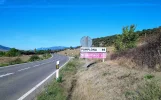- Time of past OR future Camino
- Except the Francés
A couple of weeks ago I finished walking the Camino Aragonés. It's not a very popular camino, but I enjoyed most of it very much. In theory it starts at Somport, on the French border, but I started walking a few days earlier, at Pau.
The French side is nothing spectacular except for the views of the Pyrenees getting steadily closer and more daunting. I had heard bad things about the Somport crossing, so decided to go over on the Haute Route Pyrenées, a little bit further east, taking an extra day. If you've got the time, I highly recommend it, going up the spectacular Chemin de la Mâture cliff path, and on up past the lovely Lacs d'Ayous, staying in a mountain refuge at nearly 2000m up, with the brightest clearest stars ever.
On the Spanish border, on the Col des Moines, at 2150m, where for centuries monks welcomed pilgrims coming from Arles and southern France, you have amazing views back over France and Midi d'Ossau, and down into Spain. You also very quickly pass the source of the Aragón River, not looking like something to give its name to a kingdom.
You rejoin the official camino down at Somport, near the hospital of Santa Cristina, according to the Codex Calixtines the third largest in the world.
By the time you get to the huge, formerly international, station at Canfranc, the Aragón is already big enough for its first hydroelectric plant.
As well as the ever-present beauty of the Pyrenees, there is some world-class man-made beauty on or near this route, in particular the royal monasteries of San Juan de la Peña and Leyre, the fabulous collection of Romanesque Wall paintings and sculpture in the museum at Jaca cathedral. The camino joins the Francés near Eunate Church.
Accommodation is pretty good. I stayed in two mountain refuges, four municipal albergues, two private ones, a monastery one and three pensións/hotels. The albergues were all fine, with between three and six people in each. I liked Lescar's and Sangüesa's the most, and Oloron St Marie's the least. Sadly I didn't get to Arres, which everybody says is wonderful, as I was heading up to Leyre on the other side of the reservoir.
As with much of upland Spain, the depopulation of the area was sad. It made headline news in the Alto Aragón paper one day I was there that Undués de Lerda, on the camino not far from Arres, was celebrating the village's first baptism in 29 years.
The Foz de Lumbier gorge is another of the natural beauties of this route, and the early autumn glory of the deep woods around Leyre. Oh and sunrise over the monastery and its valley after coming out from Lauds.
Giono wrote "c'est de vents, de pluies, de neiges, de soleils, de montagnes, de fleuves, et de forêts: les vraies richesses de l'homme". You can find them all on the Aragonés.

The French side is nothing spectacular except for the views of the Pyrenees getting steadily closer and more daunting. I had heard bad things about the Somport crossing, so decided to go over on the Haute Route Pyrenées, a little bit further east, taking an extra day. If you've got the time, I highly recommend it, going up the spectacular Chemin de la Mâture cliff path, and on up past the lovely Lacs d'Ayous, staying in a mountain refuge at nearly 2000m up, with the brightest clearest stars ever.
On the Spanish border, on the Col des Moines, at 2150m, where for centuries monks welcomed pilgrims coming from Arles and southern France, you have amazing views back over France and Midi d'Ossau, and down into Spain. You also very quickly pass the source of the Aragón River, not looking like something to give its name to a kingdom.
You rejoin the official camino down at Somport, near the hospital of Santa Cristina, according to the Codex Calixtines the third largest in the world.
By the time you get to the huge, formerly international, station at Canfranc, the Aragón is already big enough for its first hydroelectric plant.
As well as the ever-present beauty of the Pyrenees, there is some world-class man-made beauty on or near this route, in particular the royal monasteries of San Juan de la Peña and Leyre, the fabulous collection of Romanesque Wall paintings and sculpture in the museum at Jaca cathedral. The camino joins the Francés near Eunate Church.
Accommodation is pretty good. I stayed in two mountain refuges, four municipal albergues, two private ones, a monastery one and three pensións/hotels. The albergues were all fine, with between three and six people in each. I liked Lescar's and Sangüesa's the most, and Oloron St Marie's the least. Sadly I didn't get to Arres, which everybody says is wonderful, as I was heading up to Leyre on the other side of the reservoir.
As with much of upland Spain, the depopulation of the area was sad. It made headline news in the Alto Aragón paper one day I was there that Undués de Lerda, on the camino not far from Arres, was celebrating the village's first baptism in 29 years.
The Foz de Lumbier gorge is another of the natural beauties of this route, and the early autumn glory of the deep woods around Leyre. Oh and sunrise over the monastery and its valley after coming out from Lauds.
Giono wrote "c'est de vents, de pluies, de neiges, de soleils, de montagnes, de fleuves, et de forêts: les vraies richesses de l'homme". You can find them all on the Aragonés.



















